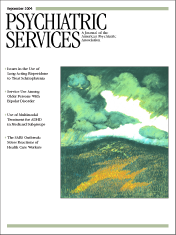Antihostility Effects of Adjunctive Divalproex
In Reply: Dr. Eilers makes the excellent point that our report of the specific antihostility effect of adjunctive valproate (given as divalproex) cannot be easily generalizable to a state hospital population. Adjunctive valproate in such settings is not usually used at the "front end" of treatment but at the "back end" when other treatments have failed. Moreover, the trial specifically excluded patients who were treatment refractory.
No reports have been published of controlled trials of sufficient magnitude to adequately answer the question of whether or not adjunctive valproate is useful for patients with persistent symptoms of schizophrenia or persistent aggressive behavior (1). The high rate of use of adjunctive valproate among patients with schizophrenia in hospitals operated by the New York State Office of Mental Health (2) is indeed astonishing and is probably comparable to rates in similar settings across the country. This widespread use of adjunctive valproate does not necessarily mean that the strategy is effective, and further research is needed. Trials of longer duration and with more chronically ill patients will be needed to test this treatment approach. As noted, our study did not provide support for a specific antihostility effect for co-prescribed valproate beyond the first week of treatment.
The parent study was valuable because it provided evidence that the major effect of adjunctive valproate appears to be on the positive symptoms of schizophrenia (3). No differences were found in the use of adjunctive lorazepam between the monotherapy and combination groups, which reduces the possibility that the ameliorative effect of valproate was by a general sedative effect. In our post hoc analysis we specifically included the presence or absence of sedation in the statistical model, as well as adjunctive use of potentially sedating rescue medication. Although the possibility of a type I error is always present, the general methodology employed is similar to that used in other published studies by our group, including a preplanned analysis that had obvious face validity in demonstrating the advantage of clozapine as an antihostility agent (4).
These issues are important for clinicians working in public-sector psychiatry, where we have the daunting responsibility of managing patients with serious and persistent mental illness, whose illness is often refractory to standard treatment approaches and who may exhibit persistent aggressive behavior. Readers of Psychiatric Services are the ideal audience for this type of open debate. More research in this area is needed.
1. Citrome L: Schizophrenia and valproate. Psychopharmacology Bulletin 37(suppl 2):74–88,2003Medline, Google Scholar
2. Citrome L, Jaffe A, Levine J: Use of mood stabilizers among patients with schizophrenia, 1994–2001. Psychiatric Services 53:1212, 2002Link, Google Scholar
3. Casey DE, Daniel DG, Wassef AA, et al: Effect of divalproex combined with olanzapine or risperidone in patients with an acute exacerbation of schizophrenia. Neuropsychopharmacology 28:182–192, 2003Crossref, Medline, Google Scholar
4. Citrome L, Volavka J, Czobor P, et al: Effects of clozapine, olanzapine, risperidone, and haloperidol on hostility among patients with schizophrenia and schizoaffective disorder. Psychiatric Services 52:1510–1514, 2001Link, Google Scholar



